Many things can cause a rash in babies and children, and they're often nothing to worry about.
Immediate action required: Go to A&E or call 999 if your child has a rash and they:
- have a stiff neck
- are bothered by light
- seem confused
- are shaking uncontrollably
- have a fever you can't control
- have unusually cold hands and feet
- have a rash that doesn't fade when you press a glass against it
These can be signs of meningitis.
Non-urgent advice: See a GP if:
- your child seems unwell, and has a rash and a fever
Use the information on this page to get an idea of what to do about a rash. But don't self-diagnose – see a GP if you're worried.
Rash with fever
Fever and red cheeks

John Kaprielian/SCIENCE PHOTO LIBRARY
A fever and a bright-red rash on both cheeks can be slapped cheek syndrome. Your child may have a cold, and the rash can spread to the body.
It usually clears up within a week. Children's paracetamol can bring down a fever.
Blisters on hands, feet and in the mouth
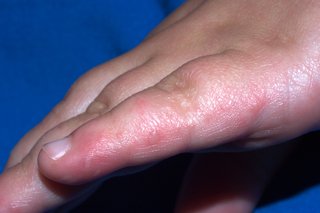
Scott Camazine / Alamy Stock Photo
Hand, foot and mouth disease is a common childhood illness that causes blisters on the hands and feet, and ulcers on the tongue. It also causes fever, and your child may have a cold.
It usually clears up in about a week. Children's paracetamol can bring down a fever.
Pink-red rash
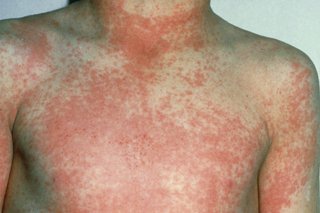
BIOPHOTO ASSOCIATES/SCIENCE PHOTO LIBRARY
Scarlet fever causes a pink-red rash, which feels like sandpaper and looks like sunburn.
It usually starts with a swollen tongue, sore throat, headache and fever.
See your GP straight away if you suspect scarlet fever. It's treated with antibiotics.
Red-brown rash
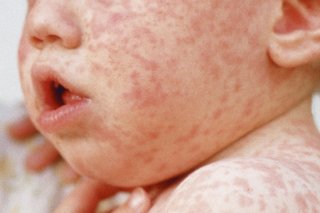
LOWELL GEORGIA/SCIENCE PHOTO LIBRARY
Measles usually starts with a fever, sore eyes that are sensitive to light and grey spots inside the cheeks.
After a few days, a red-brown rash appears on the head or neck and spreads to the rest of the body.
Call your GP if you think you or your child has measles.
Rash with itching
Rash caused by heat
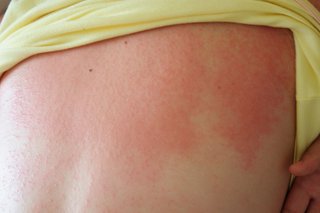
Disney Magic / Alamy Stock Photo
Heat and sweat can cause small red spots known as prickly heat or heat rash. It itches, so you may notice your baby scratching.
Heat rash should clear up without treatment.
Scaly red skin or cracked skin

DR P. MARAZZI/SCIENCE PHOTO LIBRARY
Skin that's itchy, red, dry and cracked may be eczema. It's common behind the knees, elbows and neck, but it can appear anywhere.
Speak to your GP if you think your child has eczema.
Raised itchy spots

Loisjoy Thurstun / Alamy Stock Photo
A raised, itchy red rash (hives) can appear as an allergic reaction to things like stings, medicines or food.
It usually clears up within a day or 2.
Speak to your GP if your child keeps getting this type of rash. They may be allergic to something.
Call 999 if there's swelling around their mouth.
Itchy round rash
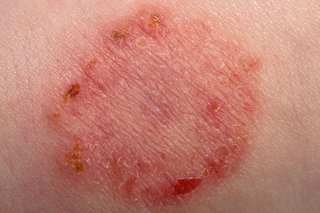
Robert Read / Alamy Stock Photo
An itchy, ring-like rash can be ringworm.
Ask your pharmacist for a cream or lotion to treat ringworm.
Speak to your GP if it appears on your child's scalp, as it may need to be treated with medicine.
Small spots and blisters
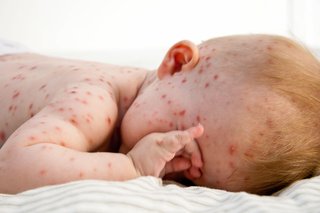
Phanie / Alamy Stock Photo
Chickenpox causes red spots that turn to blisters. They can be itchy. They eventually scab and fall off.
Some children have a few spots, while others have them all over their body.
Itchy red sores or blisters
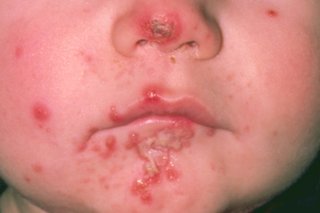
DR P. MARAZZI/SCIENCE PHOTO LIBRARY
Red sores or blisters that burst and leave crusty, golden-brown patches could be impetigo.
The sores or blisters can be itchy, get bigger or spread to other parts of the body. They often appear on the face, hands or around the middle of the body.
Speak to your GP if your child may have impetigo.
Tiny and very itchy spots
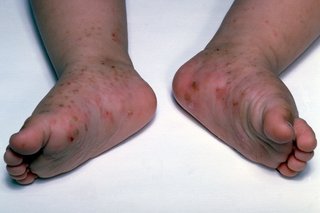
Alamy Stock Photo
Scabies is caused by tiny mites that burrow into the skin.
Ask your pharmacist for a cream or lotion to treat scabies. Everyone in the household needs to be treated at the same time – even if they don't have symptoms.
You should take your baby to a GP for advice if they are under 2 months old.
Rash without fever or itching
White spots in babies
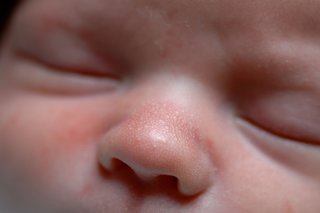
Jack Sullivan / Alamy Stock Photo
Small white spots (milia) often appear on a baby's face when they're a few days old.
They usually clear up within a few weeks and don't need treatment.
Red, yellow and white spots in babies
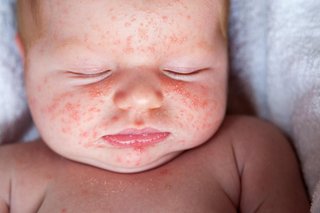
David Gee 4 / Alamy Stock Photo
Raised red, yellow and white spots (erythema toxicum) can appear on babies when they're born. They usually appear on the face, body, upper arms and thighs.
The rash can disappear and reappear.
It should clear up in a few weeks without treatment.
Pink or skin-coloured spots
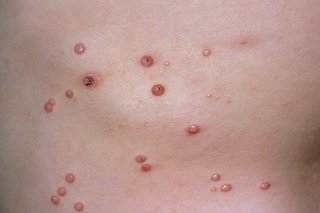
DR P. MARAZZI/SCIENCE PHOTO LIBRARY
Small, firm, raised spots that can appear anywhere on the body are common in children and known as molluscum contagiosum.
Treatment isn't recommended because the spots clear up on their own, although it can take more than a year.
Red patches on a baby's bottom
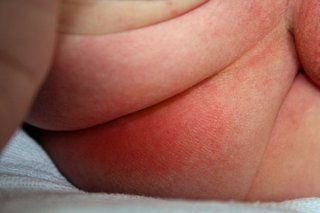
Family / Alamy Stock Photo
Nappy rash can be red patches on your baby's bottom or around the whole nappy area.
The skin may look sore and feel hot. There may be spots or blisters. It can make your child feel uncomfortable or distressed.
You can buy cream from your pharmacy to help clear it up.
Pimples on the cheeks, nose and forehead
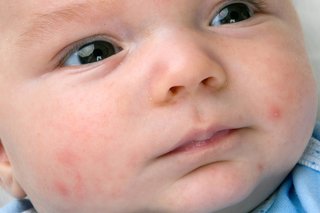
sframephoto / Thinkstock
Steven Frame / Alamy Stock Photo
Baby acne can appear within a month after birth but usually clears up after a few weeks or months.
Washing your baby's face with water and a mild moisturiser can help.
Do not use acne medicines intended for older children and adults.
Yellow, scaly patches on the scalp
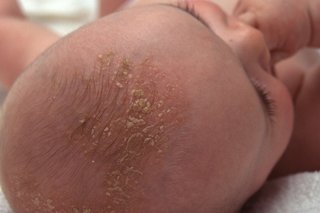
Angela Hampton Picture Library / Alamy Stock Photo
Cradle cap is when a baby gets yellowish, greasy scaly patches on their scalp.
It usually gets better without treatment in a few weeks or months.
Gently washing your baby's hair and scalp with baby shampoo may help prevent more patches.
Page last reviewed: 15 February 2018
Next review due: 15 February 2021
